6.4: Sum and Difference Identities
( \newcommand{\kernel}{\mathrm{null}\,}\)
Learning Objectives
- Use sum and difference formulas for sine, cosine, and tangent.
- Use sum and difference formulas to solve equations.
- Use sum and difference formulas to verify identities.
The trigonometric identities we will examine in this section can be traced to a Persian astronomer who lived around 950 AD, but the ancient Greeks discovered these same formulas much earlier and stated them in terms of chords. These are special equations or postulates, true for all values input to the equations, and with innumerable applications.
In this section, we will learn techniques that will enable us to solve problems such as the ones presented above. The formulas that follow will simplify many trigonometric expressions and equations. Keep in mind that, throughout this section, the term formula is used synonymously with the word identity.
Sum and Difference Formulas for Cosine
Finding the exact value of the sine, cosine, or tangent of an angle is often easier if we can rewrite the given angle in terms of two angles that have known trigonometric values. The sum and difference formulas for cosine are given below. We can use special angles and directly obtain the cosine of an angle that is the combination of known "special" angles. Alternatively, we may be a given trigonometric ratio and the quadrant the angle is in, and from that information, indirectly deduce the cosine of an angle described in this way.
Cosine: Sum and Difference Formulas
cos(α+β)=cosαcosβ−sinαsinβ
cos(α−β)=cosαcosβ+sinαsinβ
Proof of difference formula for cosines
First, we will prove the difference formula for cosines. Let’s consider two points on the unit circle illustrated in the figure to the right. Point P is at an angle α from the positive x-axis with coordinates (cosα,sinα) and point Q is at an angle of β from the positive x-axis with coordinates (cosβ,sinβ). Note the measure of angle POQ is α−β.
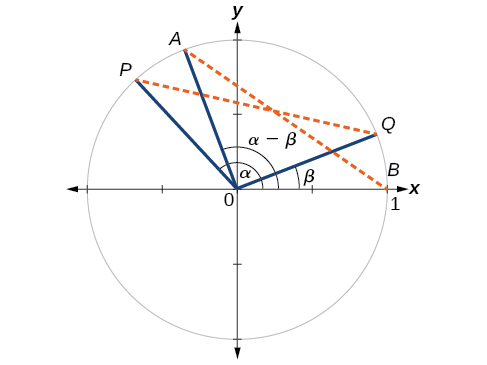 Label two more points: A at an angle of (α−β) from the positive x-axis with coordinates (cos(α−β),sin(α−β)); and point B with coordinates (1,0). Triangle POQ is a rotation of triangle AOB and thus the distance from P to Q is the same as the distance from A to B.We can find the distance from P to Q using the distance formula.
Label two more points: A at an angle of (α−β) from the positive x-axis with coordinates (cos(α−β),sin(α−β)); and point B with coordinates (1,0). Triangle POQ is a rotation of triangle AOB and thus the distance from P to Q is the same as the distance from A to B.We can find the distance from P to Q using the distance formula.
dPQ=√(cosα−cosβ)2+(sinα−sinβ)2=√cos2α−2cosαcosβ+cos2β+sin2α−2sinαsinβ+sin2β =√(cos2α+sin2α)+(cos2β+sin2β)−2cosαcosβ−2sinαsinβ=√1+1−2cosαcosβ−2sinαsinβ=√2−2cosαcosβ−2sinαsinβ
Similarly, using the distance formula we can find the distance from A to B.
dAB=√(cos(α−β)−1)2+(sin(α−β)−0)2=√cos2(α−β)−2cos(α−β)+1+sin2(α−β)=√(cos2(α−β)+sin2(α−β))−2cos(α−β)+1=√1−2cos(α−β)+1=√2−2cos(α−β)
Equating these two distances, we get √2−2cos(α−β)=√2−2cosαcosβ−2sinαsinβ. If we then square both sides, subtract 2 from both sides and divide both sides by −2, the result is the difference formula for cosine: cos(α−β)=cosαcosβ+sinαsinβ.
Proof of sum formula for cosines
To derive the cosine of the sum of two angles, start with writing the sum of two angles as a difference, and use the difference formula we just derived.
cos(α+β)=cos(α−(−β))=cosαcos(−β)+sinαsin(−β)Use the Even/Odd Identities to remove the negative angle=cosαcos(β)−sinαsin(−β)This is the sum formula for cosine
Example 6.4.1: Find the Exact Value for the Cosine of the Difference of Two Angles
Using the formula for the cosine of the difference of two angles, find the exact value of cos(5π4−π6).
Solution
Begin by writing the formula for the cosine of the difference of two angles. Then substitute the given values.
cos(α−β)=cosαcosβ+sinαsinβcos(5π4−π6)=cos(5π4)cos(π6)+sin(5π4)sin(π6)=(−√22)(√32)−(√22)(12)=−√64−√24=−√6−√24
Keep in mind that we can always check the answer using a calculator in radian mode.
![]() Try It 6.4.1:
Try It 6.4.1:
Find the exact value of cos(π3−π4).
- Answer
-
√2+√64
Example 6.4.2: Find the Exact Value for the Cosine of the Sum of Two Angles
Find the exact value of cos(75°).
Solution
As 75°=45°+30°,we can evaluate cos(75°) as cos(45°+30°).
cos(α+β)=cosαcosβ−sinαsinβcos(45∘+30∘)=cos(45∘)cos(30∘)−sin(45∘)sin(30∘)=√22(√32)−√22(12)=√64−√24=√6−√24
Keep in mind that we can always check the answer using a calculator in degree mode.
Analysis
Note that we could have also solved this problem using the fact that 75°=135°−60°.
cos(α−β)=cosαcosβ+sinαsinβcos(135∘−60∘)=cos(135∘)cos(60∘)+sin(135∘)sin(60∘)=(−√22)(12)+(√22)(√32)=−√24+√64=√6−√24
![]() Try It 6.4.2
Try It 6.4.2
Find the exact value of cos(105°).
- Answer
-
√2−√64
Sum and Difference Formulas for Sine
The sum and difference formulas for sine can be derived in the same manner as those for cosine, and they resemble the cosine formulas.
Sine: Sum and Difference Formulas
sin(α+β)=sinαcosβ+cosαsinβ
sin(α−β)=sinαcosβ−cosαsinβ
Proof of the sum and difference formulas for sine
The derivation for the sine of a sum of two angles can be shown using the Cofunction Identities and the formula for the cosine of the difference of two angles.
sin(α+β)=cos(π2−(α+β))Cofunction Identity: sinA=cos(π/2−A)=cos((π2−α)−β)=cos(π2−α)⋅cosβ+sin(π2−α)⋅sinβCosine of a difference of angles formula=sinαcosβ+cosαsinβCofunction Identity: cos(π/2−A)=sinA
The derivation for the sine of a difference of two angles comes from using the formula for the sine of the sum of two angles.
sin(α−β)=sin(α+(−β))=sinαcos(−β)+cosαsin(−β)=sinαcosβ−cosαsinβEven/Odd Properties
Example 6.4.3: Using Sum and Difference Identities to Evaluate the Difference of Angles
Use the sum and difference identities to evaluate the difference of the angles and show that part a equals part b.
- sin(45°−30°)
- sin(135°−120°)
Solution
- Let’s begin by writing the formula and substitute the given angles.
sin(α−β)=sinαcosβ−cosαsinβsin(45∘−30∘)=sin(45∘)cos(30∘)−cos(45∘)sin(30∘)
Next, we need to find the values of the trigonometric expressions.
sin(45°)=√22,cos(30°)=√32,cos(45°)=√22,sin(30°)=12
Now we can substitute these values into the equation and simplify.
sin(45°−30°)=√22(√32)−√22(12)=√6−√24
- Again, we write the formula and substitute the given angles.
sin(α−β)=sinαcosβ−cosαsinβsin(135∘−120∘)=sin(135∘)cos(120∘)−cos(135∘)sin(120∘)
Next, we find the values of the trigonometric expressions.
sin(135°)=√22,cos(120°)=−12,cos(135°)=√22,sin(120°)=√32
Now we can substitute these values into the equation and simplify.
sin(135∘−120∘)=√22(−12)−(−√22)(√32)=√6−√24
Example 6.4.4: Finding the Exact Value of an Expression Involving an Inverse Trigonometric Function
Find the exact value of sin(cos−112+sin−135). Then check the answer with a graphing calculator.
Solution
The pattern displayed in this problem is sin(α+β), where α=cos−112 and β=sin−135. Then we can write
cosα=12,0≤α≤πsinβ=35,−π2≤β≤π2
We will use the Pythagorean identities to find sinα and cosβ
sinα=√1−cos2α=√1−14=√34=√32
cosβ=√1−sin2β=√1−925=√1625=45
Using the sum formula for sine,
sin(cos−112+sin−135)=sin(α+β)=sinαcosβ+cosαsinβ=√32⋅45+12⋅35=4√3+310
Sum and Difference Formulas for Tangent
Finding the sum of two angles formula for tangent involves taking quotient of the sum formulas for sine and cosine and simplifying. Recall, tanx=sinxcosx, when cosx≠0.
tan(α+β)=sin(α+β)cos(α+β)=sinαcosβ+cosαsinβcosαcosβ−sinαsinβ=sinαcosβ+cosαsinβcosαcosβcosαcosβ−sinαsinβcosαcosβ=sinαcosβcosαcosβ+cosαsinβcosαcosβcosαcosβcosαcosβ−sinαsinβcosαcosβ=sinαcosα+sinβcosβ1−sinαsinβcosαcosβ=tanα+tanβ1−tanαtanβ
We can derive the difference formula for tangent by using the sum formula above, plus the Odd/Even Identity for tangent.
Tangent: Sum and Difference Formulas
tan(α+β)=tanα+tanβ1−tanαtanβ
tan(α−β)=tanα−tanβ1+tanαtanβ
Example 6.4.5: Finding the Exact Value of an Expression Involving Tangent
Find the exact value of tan(π6+π4).
Solution
Let’s first write the sum formula for tangent and then substitute the given angles into the formula.
tan(α+β)=tanα+tanβ1−tanαtanβtan(π6+π4)=tan(π6)+tan(π4)1−(tan(π6))(tan(π4))
Next, we determine the individual function values within the formula:
tan(π6)=1√3,andtan(π4)=1
So we have,
tan(π6+π4)=1√3+11−(1√3)(1)=1+√3√3√3−1√3Simplify the complex fraction=1+√3√3⋅√3√3−1=√3+1√3−1Rationalize the denominator=√3+1√3−1⋅√3+1√3+1Multiply out=3+√3+√3+13+√3−√3−1Simplify=4+2√32=2+√3Simplify
![]() Try It 6.4.5:
Try It 6.4.5:
Find the exact value of tan(2π3+π4).
- Answer
-
1−√31+√3
Example 6.4.6: Finding Multiple Sums and Differences of Angles
Given sinα=35,0<α<π2, and cosβ=−513,π<β<3π2, find
a. sin(α+β) b. cos(α+β) c. tan(α+β) d. tan(α−β)
Solution
We can use the sum and difference formulas to identify the sum or difference of angles when the ratio of sine, cosine, or tangent is provided for each of the individual angles. To do so, we construct what is called a reference triangle to help find each component of the sum and difference formulas. Since these formulas will need the sine, cosine or tangent of angle α and β, we will determine them here and then use the results below.
|
Given sinα=35,0<α<π2,
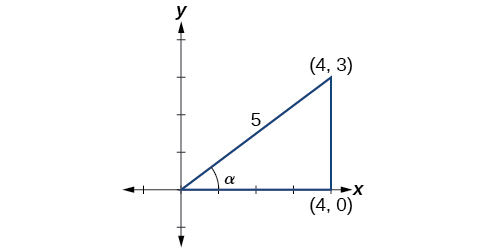
sinα=35, cosα=45, tanα=34 |
Given cosβ=−513,π<β<3π2
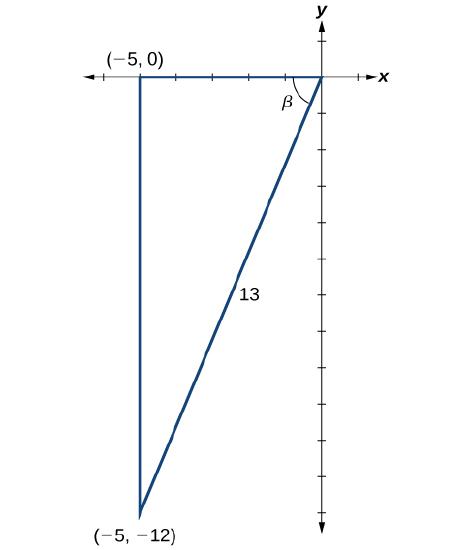
sinβ=−1213, cosβ=−513, tanβ=125 |
Now we are ready to use the formulas and perform the appropriate substitutions.
- To find sin(α+β),
sin(α+β)=sinαcosβ+cosαsinβ=(35)(−513)+(45)(−1213)=−1565−4865=−6365
- Find cos(α+β)
cos(α+β)=cosαcosβ−sinαsinβ=(45)(−513)−(35)(−1213)=−2065+3665=1665
- For tan(α+β)
tan(α+β)=tanα+tanβ1−tanαtanβ=34+1251−34(125)=6320−1620=−6316
- To find tan(α−β)
tan(α−β)=tanα−tanβ1+tanαtanβ=34−1251+34(125)=−33205620=−3356
Use Sum and Difference Formulas to Solve Equations
These identities can also be used to solve equations.
Example 6.4.7
Solve sin(x)sin(2x)+cos(x)cos(2x)=√32.
Solution
By recognizing the left side of the equation as the result of the difference of angles identity for cosine, we can simplify the equation
cos(x)cos(2x)+sin(x)sin(2x)=√32Apply the difference of angles identitycos(x−2x)=√32cos(−x)=√32Use the negative angle identitycos(x)=√32
Since this is a special cosine value, so we can quickly write the answers: x=π6+2πk and x=11π6+2πk, where k is any integer
Use Sum and Difference Formulas to Verify Identities
Verifying an identity means demonstrating that the equation holds for all values of the variable. It helps to be very familiar with the identities or to have a list of them accessible while working the problems.
Example 6.4.8A: Verifying an Identity Involving Sine
Verify the identity sin(α+β)+sin(α−β)=2sinαcosβ.
Solution
We see that the left side of the equation includes the sines of the sum and the difference of angles.
sin(α+β)=sinαcosβ+cosαsinβ
sin(α−β)=sinαcosβ−cosαsinβ
We can rewrite each using the sum and difference formulas.
sin(α+β)+sin(α−β)=sinαcosβ+cosαsinβ+sinαcosβ−cosαsinβ=2sinαcosβ
We see that the identity is verified.
Example 6.4.8B: Verifying an Identity Involving Tangent
Verify the following identity.
sin(α−β)cosαcosβ=tanα−tanβ
Solution
We can begin by rewriting the numerator on the left side of the equation.
sin(α−β)cosαcosβ=sinαcosβ−cosαsinβcosαcosβSplit fraction apart=sinαcosβcosαcosβ−cosαsinβcosαcosβCancel=sinαcosα−sinβcosβRewrite in terms of tangent=tanα−tanβ
![]() Try It 6.4.8:
Try It 6.4.8:
Verify the identity: tan(π−θ)=−tanθ.
- Answer
-
tan(π−θ)=tan(π)−tanθ1+tan(π)tanθ=0−tanθ1+0⋅tanθ=−tanθ
Applications of Sum and Difference Formulas
Example 6.4.9A: Using Sum and Difference Formulas to Solve an Application Problem
Let L1 and L2 denote two non-vertical intersecting lines, and let θ denote the acute angle between L_1 and L_2. See Figure \PageIndex{7}. Show that
\tan \theta=\dfrac{m_2-m_1}{1+m_1m_2}
where m_1 and m_2 are the slopes of L_1 and L_2 respectively. (Hint: Use the fact that \tan \theta_1=m_1 and \tan \theta_2=m_2.)
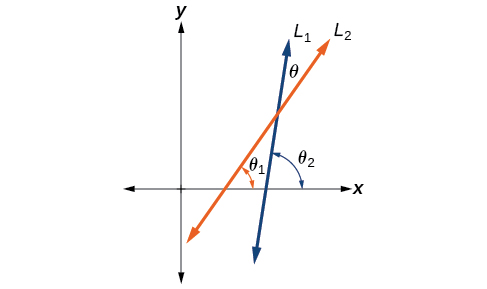
Solution
Observe that \theta_1 + (180^{\circ} - \theta_2) +\theta = 180^{\circ}. Thus \theta = \theta_2 - \theta_1. To find \theta, use the difference formula for tangent, plus the knowledge that the tangent of an angle is the slope of the terminal side of that angle when it is placed in standard position.
\begin{align*} \tan \theta&= \tan(\theta_2-\theta_1)\\[4pt] &= \dfrac{\tan \theta_2-\tan \theta_1}{1+\tan \theta_1 \tan \theta_2}\\[4pt] &= \dfrac{m_2-m_1}{1+m_1m_2} \end{align*}
Example \PageIndex{9B}: Investigating a Guy-wire Problem
For a climbing wall, a guy-wire R is attached 47 feet high on a vertical pole. Added support is provided by another guy-wire S attached 40 feet above ground on the same pole. If the wires are attached to the ground 50 feet from the pole, find the angle \alpha between the wires. See Figure \PageIndex{8}.
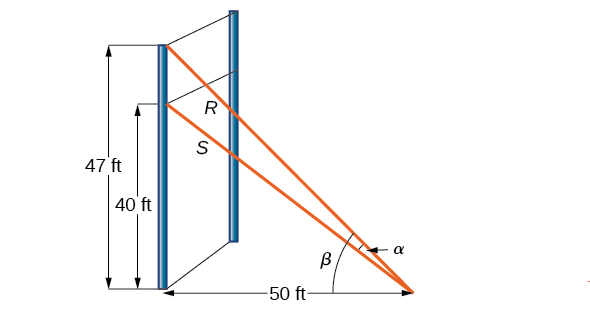
Solution
Let’s first summarize the information we can gather from the diagram. As only the sides adjacent to the right angle are known, we can use the tangent function. Notice that \tan \beta=\dfrac{47}{50}, and \tan(\beta−\alpha)=\dfrac{40}{50}=\dfrac{4}{5}. We can then use difference formula for tangent.
\tan(\beta-\alpha) = \dfrac{\tan \beta-\tan \alpha}{1+\tan \beta \tan \alpha} \nonumber
Now, substituting the values we know into the formula, we have,
\begin{align*} \dfrac{4}{5}&= \dfrac{\;\; \dfrac{47}{50}-\tan \alpha \;\;}{1+\dfrac{47}{50}\tan \alpha}\\[4pt]
4\left(1+\dfrac{47}{50}\tan \alpha\right)&= 5\left(\dfrac{47}{50}-\tan \alpha\right)\end{align*}
Use the distributive property, and then simplify the functions.
\begin{align*} 4(1)+4\left(\dfrac{47}{50}\right)\tan \alpha &= 5\left(\dfrac{47}{50}\right)-5\tan \alpha\\[4pt]
4+3.76\tan \alpha&= 4.7-5\tan \alpha\\[4pt]
5\tan \alpha+3.76\tan \alpha&= 0.7\\[4pt]
8.76 \tan \alpha&= 0.7\\[4pt]
\tan \alpha&\approx 0.07991\\[4pt]
\tan^{-1}(0.07991)&\approx .079741 \text{ radians or } 4.57^{\circ} \end{align*}
Key Equations
| Sum and Difference Formulas for Cosine | \cos(\alpha+\beta)=\cos \alpha \cos \beta−\sin \alpha \sin \beta | \cos(\alpha-\beta)=\cos \alpha \cos \beta+\sin \alpha \sin \beta |
| Sum and Difference Formulas for Sine | \sin(\alpha+\beta)=\sin \alpha \cos \beta+\cos \alpha \sin \beta | \sin(\alpha-\beta)=\sin \alpha \cos \beta-\cos \alpha \sin \beta |
| Sum and Difference Formulas for Tangent | \tan(\alpha+\beta)=\dfrac{\tan \alpha+\tan \beta}{1-\tan \alpha \tan \beta} | \tan(\alpha-\beta)=\dfrac{\tan \alpha-\tan \beta}{1+\tan \alpha \tan \beta} |
|
Cofunction identities |
\sin \theta=\cos\left(\dfrac{\pi}{2}-\theta\right) \cos \theta=\sin\left(\dfrac{\pi}{2}-\theta\right) \tan \theta=\cot\left(\dfrac{\pi}{2}-\theta\right) |
\cot \theta=\tan\left(\dfrac{\pi}{2}-\theta\right) \sec \theta=\csc\left(\dfrac{\pi}{2}-\theta\right) \csc \theta=\sec\left(\dfrac{\pi}{2}-\theta\right) |
Key Concepts
- The sum formula for cosines states that the cosine of the sum of two angles equals the product of the cosines of the angles minus the product of the sines of the angles. The difference formula for cosines states that the cosine of the difference of two angles equals the product of the cosines of the angles plus the product of the sines of the angles.
- The sum and difference formulas can be used to find the exact values of the sine, cosine, or tangent of an angle.
- The sum formula for sines states that the sine of the sum of two angles equals the product of the sine of the first angle and cosine of the second angle plus the product of the cosine of the first angle and the sine of the second angle. The difference formula for sines states that the sine of the difference of two angles equals the product of the sine of the first angle and cosine of the second angle minus the product of the cosine of the first angle and the sine of the second angle.
- The sum formula for tangent states that the tangent of the sum of two angles equals the sum of the tangents of the angles divided by 1 minus the product of the tangents of the angles. The difference formula for tangent states that the tangent of the difference of two angles equals the difference of the tangents of the angles divided by 1 plus the product of the tangents of the angles.
- The Pythagorean Theorem along with the sum and difference formulas can be used to find multiple sums and differences of angles.
- The cofunction identities apply to complementary angles and pairs of reciprocal functions.
- Sum and difference formulas are useful in verifying identities.
- Application problems are often easier to solve by using sum and difference formulas.
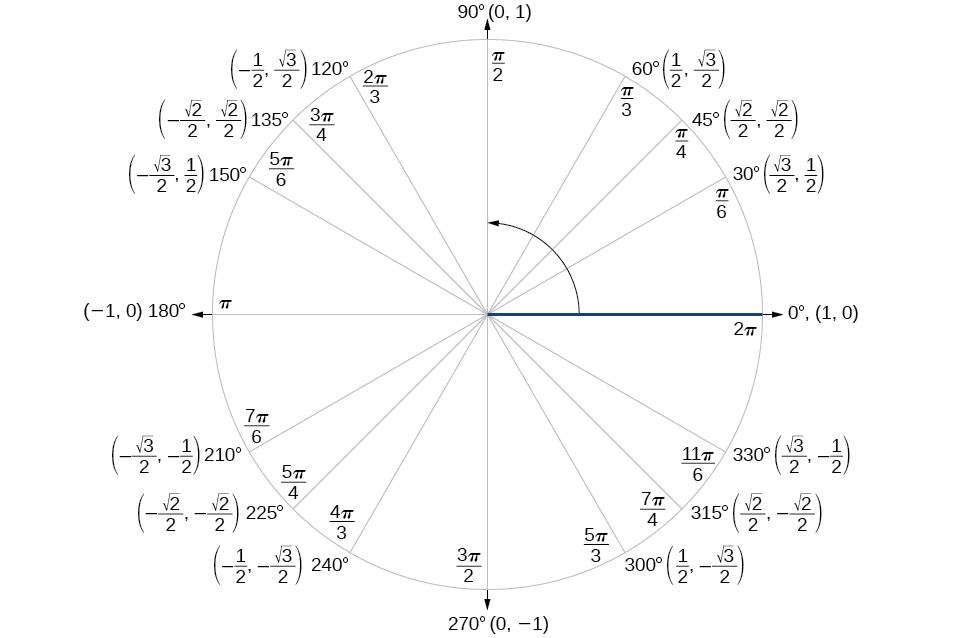
Contributors and Attributions
Jay Abramson (Arizona State University) with contributing authors. Textbook content produced by OpenStax College is licensed under a Creative Commons Attribution License 4.0 license. Download for free at https://openstax.org/details/books/precalculus.

